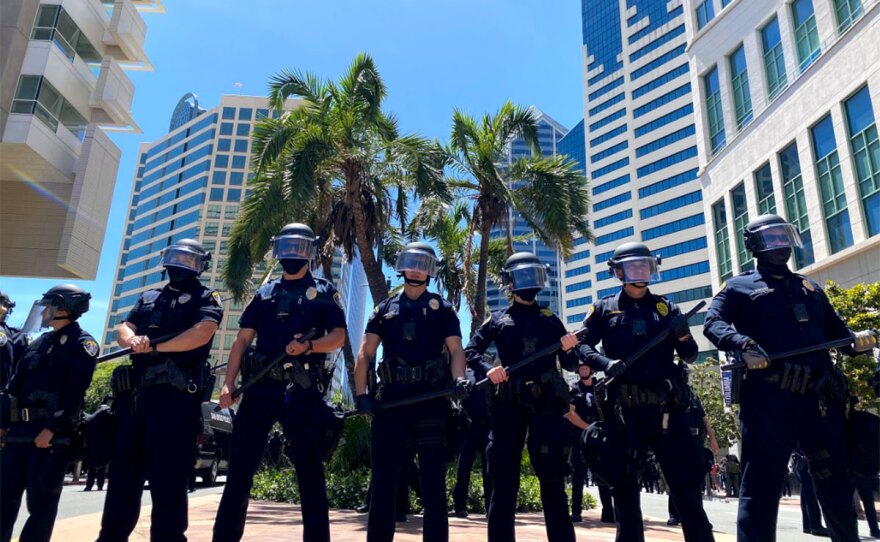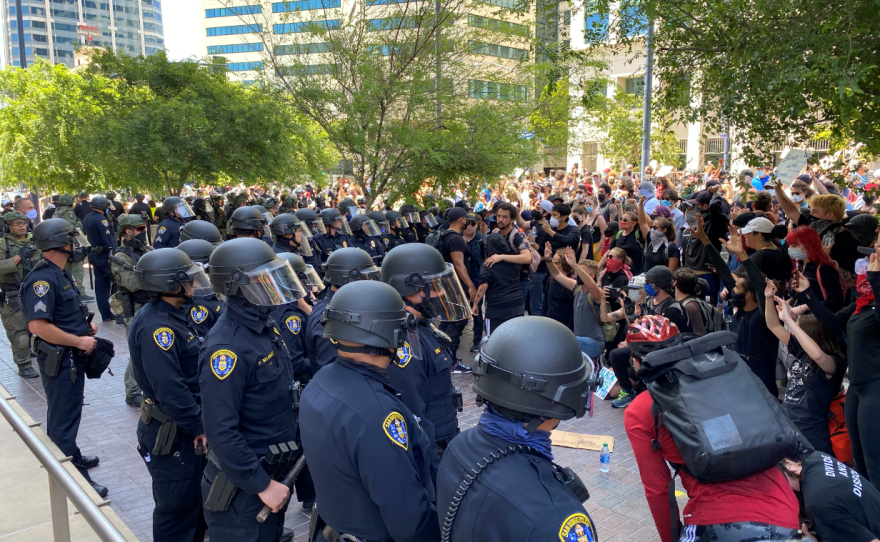San Diego County braces for its fifth day of unrest.
Tuesday night, demonstrators marched through Balboa Park and parts of Hillcrest, as organizers called for participants to keep the peace and refrain from vandalizing property.
Each day holds potential for more protests, as President Donald Trump threatens to use the U.S. military to supplement local police forces.
Over the last weekend of May, glass, tear gas and sirens cascaded down the streets of downtown San Diego and La Mesa. In Santee and Poway, business owners frantically boarded up their stores and residents waited in anticipation of another protest in their backyards.
These events unfolded as San Diego county demonstrators joined national and international protests in reaction to the death of George Floyd in Minneapolis.
Floyd, a black man, died on Memorial Day after he was handcuffed and pinned to the ground by the knee of Derek Chauvin, a white police officer. Chauvin has since been charged with third-degree murder and manslaughter.
Back in San Diego, protests first erupted in La Mesa because of an incident in late May, where a white La Mesa police officer is shown on video repeatedly trying to force a black man to sit down while he was being detained near a trolley station.
Converging on La Mesa: Saturday afternoon
Hundreds of people — who at one point filled five city blocks on University Avenue — gathered to protest outside of the La Mesa Police Department. It was San Diego’s first large-scale protest since unrest broke out across the country in late May, in response to the death of George Floyd.
“I have been seeing this all my life. I’m 70 years old. And it’s never stopped. Because of social media, we’re getting some attention,” said protester Roberta Tatum. “We need to understand, if the law do not start protecting black people, I don’t know what’s going to happen.”

After organizers addressed the crowd, the march left police headquarters and wound through University Avenue, eventually arriving at Interstate 8, where demonstrators were intercepted by California Highway Patrol officers. After a brief conversation with the protesters, the Highway Patrol let them pass, and they made their way onto the highway and blocked traffic for hours.
When protesters returned to the La Mesa Police Department, San Diego County Sheriff’s Deputies had formed a barricade to block the entrance.
“Hands up, don’t shoot”: Saturday night
Demonstrators chanted while sheriff’s deputies guarded the front doors to the station. Protesters chanted “hands up, don’t shoot,” while sheriff’s deputies donned gas masks.
While the majority of protesters were on the highway, anti-police graffiti had been written on the walls of the police headquarters, and a window had been broken in the station’s outdoor garage.
Shortly after 6 p.m., the tension broke into a wave of smoke. The sheriff said they issued an order to disperse beforehand, but a KPBS crew who was in front of the police department, didn't hear an audible warning. Protesters ran to the street as numerous rounds of tear gas and projectiles rained down from deputies on the roof of the police station.
One woman, 59-year-old Leslie Furcron, is in an intensive care unit in a medically induced coma and may lose one of her eyes after being shot in the face by law enforcement with a rubber bullet, according to her family and their attorney.
Furcron’s family is now calling for “swift and decisive action” against the officer who fired the projectile, which they say struck her in the forehead.
San Diego resident and protester Manny Planes said he was hit with tear gas.
“They started firing at us, they started shooting, we were peaceful at first,” Planes said. “It comes down to that, sometimes, you have to fight back fire with fire, if you really want change to happen. If it has to come to this, then it is what it is. We’re demanding change.”

A few hours later, after police cleared the parking lot in front of the police station, two vehicles outside of City Hall were set on fire. Another was ablaze a block away on University Avenue.
Soon, some people began breaking windows and looting stores at the La Mesa Springs Shopping Center. People with baseball bats repeatedly hit an ATM, and the storefront window at Vons grocery. One man took a surfboard.

Nearby, the local Chase and Union banks burned.

Picking up the pieces: Sunday morning
Surveying ransacked stores and burned buildings, a resident of nearby Spring Valley compared the destruction to “a war zone.”
Mary Duty said she was among the protesters Saturday evening, but went home after police began launching tear gas and rubber bullets into crowds gathered at the La Mesa Police Department.
“I come back this morning — it’s like a war zone. It felt like we’re actually in a war,” Duty said while standing near the Randall Lamb Associates building that was charred from an earlier blaze.
Community members cleaned up shattered windows and vandalized storefronts.

Duty, a retired teacher and mother of a 31-year-old black son, said she was particularly affected by the death of George Floyd.
“He’s been detained by the police, so it’s right at home for me,” she said. “This is right at home when you let the police off and saying it’s OK — it’s not OK.”
Duty said she was shocked by the damage from protesters but did not want to judge their actions.
“I can’t judge somebody else’s anger or how they’re going to protest, it is what it is. If this is the way of getting the world's attention, then that’s how it’s going to have to be,” she said.

The owner of Play It Again Sports, Daniel Buxton, surveyed his store, where the sprinklers remained on for several hours. But he was encouraged by what he saw as members of the community came together to help him clean up.
“I thought it was going to take a month, but with this kind of turnout, maybe it’ll take a week, maybe less, maybe a day,” he said.
Buxton remained supportive. He said people have a right to speak out against perceived injustice.
“I just never wanted it to turn into this obviously, and I don't think this accomplishes anything for anybody, but I do think that people have a right to protest and should if they feel that they want to,” he said.
San Diego joins the protest: Sunday afternoon
With megaphones and signs in tow, hundreds of people gathered at the Hall of Justice downtown.
The crowd marched east to the police headquarters, temporarily shutting down Interstate 5.

"We just want to be heard … we want everybody to know we stand in solidarity with George Floyd," said Ariel Gibbs, one of the event's organizers. "Hopefully we are heading for change. We see that we need a community review board to hold police accountable."
Organizers throughout the day urged the crowd to be peaceful. Around 2 p.m. on Saturday, as marchers returned to the Hall of Justice, police formed barricades on both sides of protesters. Some protesters threw water bottles at law enforcement.

A few feet away from that confrontation, Hafsa Yussuf and her sister, Amina, came to the protest to make their voices heard. “We wanted to stand with the black community and everyone who has been hurt by the police and felt injustice,” said 15-year-old Hafsa.
“I felt like it was going pretty smoothly until the cops showed up, we were just walking around downtown and chanting black lives matter … They’re barricading people in … I’m scared,” Yussuf said.

Several protesters appeared eager to maintain the peace. Instigators were quickly identified by others in the group.
People encircled a man who smashed a window at Citibank on Broadway and ordered him to leave. Three others stepped in front of the shattered glass to prevent further damage or looting.

Just around the corner, three demonstrators in their 20s engaged two officers in constructive conversations.
At one point, protesters were pushed out from the Hall of Justice area and found themselves corralled on Broadway at Horton Plaza. Tensions rose as tear gas and flash bangs were once again used on the crowd.
“I think the police need to completely rethink their tactics when dealing with these crowds,” said protester William Rodriguez-Kennedy. Kennedy is also the head of the San Diego Democratic Party. He was still wiping tear gas from his eyes when he spoke to KPBS.
“It would have been interesting if the police had taken a knee with us, or if the chief or the mayor or someone in leadership in this city decided to show empathy and share their pain about black and brown man being shot in the streets.”

KPBS spoke to the president of the San Diego Police Officers Association, detective Jack Schaeffer. He said police responded to protesters with force because they had “bricks, rocks, bottles thrown at them,” and “they're vulnerable because they're standing there on a post.”
KPBS questioned that response by noting none of the four reporters in the field had seen dangerous projectiles, like rocks, thrown at police officers before tear gas was used.
Schaeffer responded “the people who are there to disrupt and cause violence,” were hidden within the larger crowd of protestors. So, it’s likely that many people did not see them. But, he said, “we can't just leave our officers there to be targets.”
“I don’t know there’s a technique (to stop violence at protests) that can be used to make everybody happy,” Schaeffer said.
Tear gas and non-lethal projectiles continued to rain on protesters through much of the afternoon and evening in downtown San Diego on May 31.

Clashes between protesters and police paused for a moment, as protesters gathered at the waterfront for an early evening vigil in memory of the numerous people of color who have died due to police brutality.
Poetry and music filled the park.

But tensions escalated again as police used tear gas on protesters who had lingered around downtown hours after the vigil had ended. Around 10 p.m., people began looting the AT&T store on Broadway and Third Avenue as well as the nearby CVS on Broadway and Fifth Avenue.
By the end of the night, the San Diego Police Department said 94 people were arrested for charges ranging from failure to disperse to assaulting officers and vandalism.
In downtown San Diego, already hollowed out by the coronavirus pandemic, residents and business owners braced themselves for the next morning: a day of clean up and another possible protest.
Protesters versus looters
Many protesters say protests were meant to be peaceful marches to address police brutality and racial injustice. Many allies of the Black Lives Matter movement say the rioting and looting undermines the point of the protests in the first place.
Latoya Sanchez joined the demonstration downtown San Diego on Sunday.
“We’re not fighting violence with violence. Some people may think that but that’s not what the Black Lives movement is built on,” she said.
After reaching the police headquarters downtown, she paused to catch a breath. The incident in La Mesa the last weekend of May left her feeling hurt and exhausted.
“All we keep hearing is 'Oh they’re looting and rioting.' That has nothing to do with us,” said Sanchez.

On Monday afternoon, San Diego Police Chief David Nisleit said the vast majority of protesters had peaceful intentions. He spoke to the 94 arrests made over the weekend.
“About a quarter of those folks are outside the San Diego areas. So we do know historically, nationally, when we look at protests, that we will have people come in from other parts of the country to do this very thing,” he said.
Violence he said is in some ways expected in these situations.
“There’s people that will come to this town with the sole goal of anarchy,” Nisleit said.
But the rumors of who initiated looting and rioting had already started over the weekend. Some pointed to the far left. Others blamed white supremacists. And some called out the protesters.
Questioning a double standard
Across the country, police departments have resorted to the use of these tactics to break up large groups of protesters. At the same time, law enforcement has left stores and commercial districts mostly unguarded.
In San Diego, tear gas was most recently used in November of 2018, when Customs and Border Protection agents used it as a march of asylum-seekers approached the border in San Ysidro.
Tear gas and pepper ball rounds were also used by local law enforcement to disperse crowds during protests surrounding the death of Alfred Olango in 2016.
In a statement following protests over the weekend, San Diego County Sheriff Bill Gore said that deputies “followed their training in managing crowds and maintaining public safety.”
The American Civil Liberties Union of San Diego and Imperial Counties said in a statement Monday police should treat protesters in city streets much in the same way they treated overwhelmingly white protesters earlier this year, during protests against the county’s “stay-at-home” order.

At the time, the San Diego Police Department told KPBS that despite the “stay-at-home” order, SDPD had decided not to enforce it during the protests. A spokesperson said the police department recognized then that people wanted to voice their frustrations and concerns in a peaceful way.
“We strongly urge law enforcement to exercise compassion and restraint in protecting people’s constitutional rights and not to overreact to public protest with unnecessary, militarized policing,” the ACLU wrote of local law enforcement’s reaction to this weekend’s protests.
Local community leaders recognized the unequal response as well. At a press conference Monday afternoon, Rodriguez-Kennedy, the County Democratic Chair who was tear gassed on Sunday, called out the San Diego Police Department.
“When they were protesting the coronavirus stay-at-home orders, we didn’t see an army of police downtown to contain them, we didn’t see the deployment of tear gas,” he said.
“There’s two crowds. One crowd was less diverse. And the crowd that was protesting yesterday was more diverse. So it says something that the police are treating these crowds differently.”
Assessing the aftermath, momentum for change
In the aftermath of the protest, San Diego Mayor Kevin Faulconer and Police Chief Nisleit on Monday changed their stance on one of the most divisive practices of the San Diego Police Department — the chokehold.
For years, police reform advocates have criticized the practice. During a press conference on Monday, Faulconer said the city would be backing off its use.
“We are watching the hurt and pain so many people are expressing after the tragic death of George Floyd and are committed to taking new actions to make sure something like this doesn't happen in San Diego," Faulconer said. "That starts today with the police chief's decision to immediately stop this particular restraint that has led to so much concern and frustration by many in our minority communities."

Faulconer also said he would support a November ballot measure that would create an independent body with oversight for possible misconduct by the San Diego Police Department. The body, which would have subpoena power, has been championed by a group known as San Diegans for Justice.
The protests over the weekend comes at a time when the city is already dealing with a confluence of other challenges: record levels of unemployment that are negatively impacting low-income communities of color, an election year and now concerns that protests could trigger a new round of COVID-19 infections.
And while promises from the San Diego Police Department could signify progress, uncertainty and tensions remain high as the city prepares itself for a potentially tumultuous summer.
Reporters Tarryn Mento and Matthew Hoffman contributed to this report.








